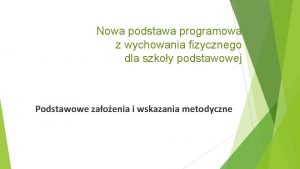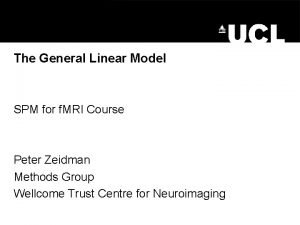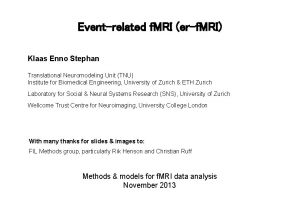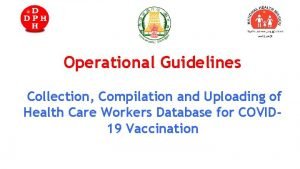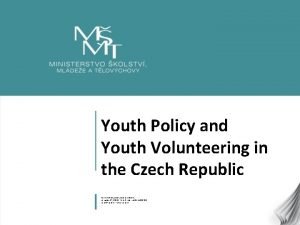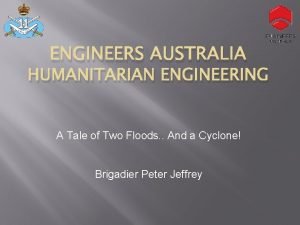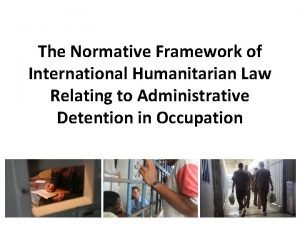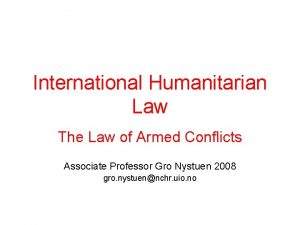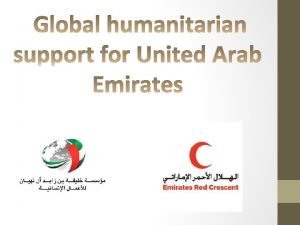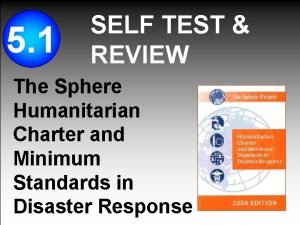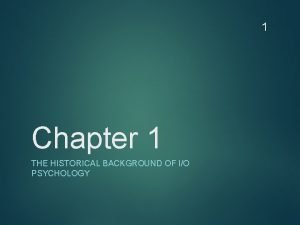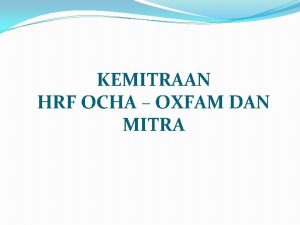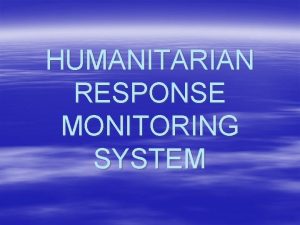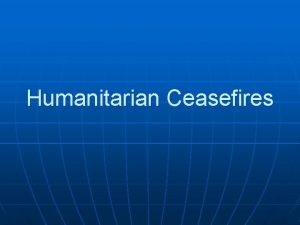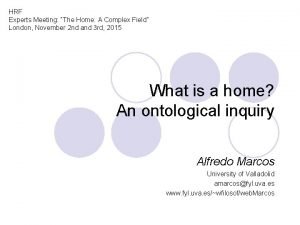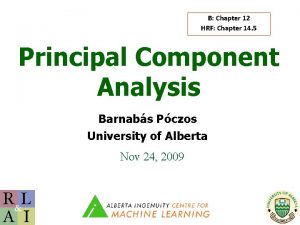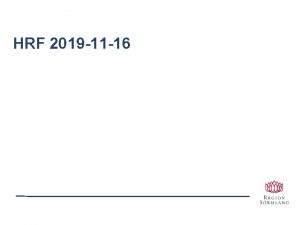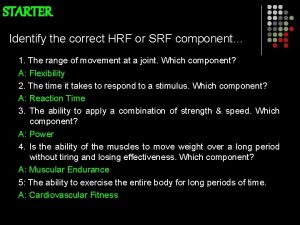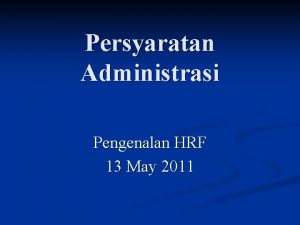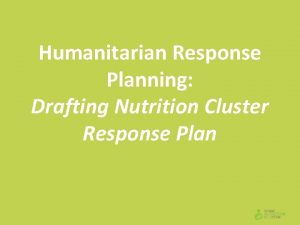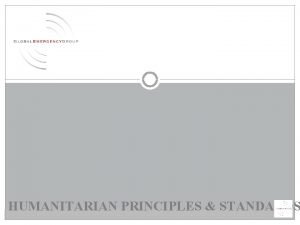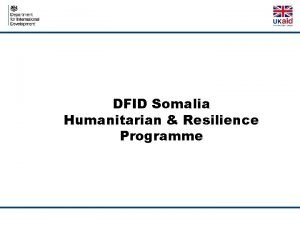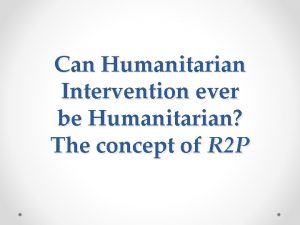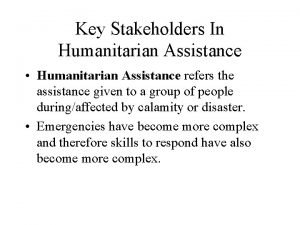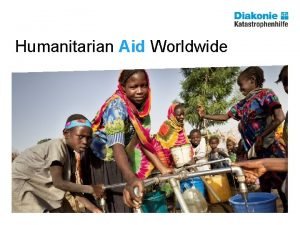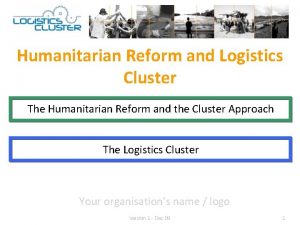HRF Humanitarian Response Forum History The Humanitarian Response






















- Slides: 22

HRF Humanitarian Response Forum

History: The Humanitarian Response Forum (HRF) was established in 2011 in response to the demand for increased coordination between development partners to address the demands of humanitarian disasters, primarily floods and drought. HRF is mostly funded by OFDA The objective of the HRF is to ensure sound coordination and communication on emergency preparedness, and humanitarian response in Cambodia between the United Nations (UN), international non-governmental organizations (INGOs), and international organizations (IOs). The HRF works in close collaboration with the Government, most notably the National Committee for Disaster Management (NCDM), to facilitate a coordinated and effective approach in support of people affected by humanitarian crises. Following the floods response in 2011 and 2013, humanitarian partners have conducted after actions reviews/lessons learned workshops in which one of the key priorities identified has been the need for stronger and more comprehensive preparedness, particularly at sectorial level.

What does HRF Do? The HRF Holds Coordination meetings and shares information HRF Coordinates the Sectors and identifies gaps or duplications in response activity HRF Standardises reporting and information gathering HRF Provides a single point of contact for other actors (NCDM, Cambodian Red Cross etc. ) to communicate and coordinate with the UN and NGO community The HRF brings in technical specialists to use their experience of emergency response to assist in improving the preparedness, planning and response activities in Cambodia The HRF Develops the tools which improve preparedness and disaster response in Cambodia HRF Led the writing of the HRF Contingency Plan adopted by UN Agencies and INGOs involved in Disaster Response in Cambodia

There are several tools developed to assist in planning and coordinating an emergency response: A Contingency Plan will ensure that everyone knows what they are supposed to do before the disaster happens. Standard Reporting and Data Collection tools mean that everyone is using the same information, so it can be shared to coordinate action. Sector Based Response means that the technical aspects of an emergency response are organised by the specialists in each sector, leaving the overall coordination of the response with the Task Force

The SECTOR based approach: In large emergencies throughout the world the work of different parts of the response is divided into Sectors which simplifies the technical aspects of emergency response. Sometimes these Sectors are known as Clusters when an emergency is large.

In Cambodia the HRF uses the same system so that any emergency response will follow the International System and can be easily understood by any emergency response body coming from anywhere in the world. This system is known as the Sector Based Approach The Sectors are also used in the NCDM National Contingency Plan: 2012, and in the draft NCP 2015

In the HRF/Cambodia context there are 6 Sectors: • Food Security and Nutrition (FSN) • Water, Sanitation and Hygiene (WASH) • Shelter • Health • Education • Protection

Each Sector works with the relevant Ministry: Example: Health Sector works with Ministry of Health, WASH sector works with Ministry of Rural Development. Thus each Sector provides TECHNICAL support on specialised areas of the response, under the overall coordination of NCDM and the Government. This is the same system as used in international disasters everywhere in the world and will be recognised by specialists from ASEAN or UN emergency teams.

6 Sectors (៦ ផន ក) Food Security & Nutrition (FSN) សនតសខសប ងនងអ ហ ររបតថមភ Shelter ជមរក Water Sanitation & Hygiene Protection ក រព រ Education អបរ Health សខភ ព WASH អន មយ ទក នង ខលនបរ ណ

HRF has developed Rapid Assessment tools to make it easier to share good quality information quickly. The Rapid Assessment questionnaires were originally developed for HRF but have been shared with NCDM and CHF. Training of Trainers sessions have been held in several provinces, most recently Kampong Thom and Battambang, to share these tools with PCDMs in order to improve the quality of information NCDM receives, and thus improve informed planning durning a disaster response. CHF is training teams including PCDM as well as CHF members who will be available, already in place, to conduct Rapid Assessments to provide information on those affected by disaster for sharing among all actors involved in responding. The Training of Trainers was funded by OFDA as part of the capacity building which the HRF does

As well as the Training of Trainers in Assessments, HRF has also run the Cam. REx with NCDM at Provincial level in Kampong Thom and Battambang, completing two-day exercises at each location earlier this month.

HRF facilitated the Cam. REx 2016 simulation exercise held in Phnom Penh in July 2016, the most recent of a series of Simulation Exercises held annually

Scenes from the Cam. REx in Phnom Penh 2016 The WASH Sector delivers their report during the National Cam. REx 2016

HRF has a Website to share news, information, contacts and maps: The web address of the HRF website is: https: //www. humanitarianresponse. info/en/operations/cambodia

The HRF Website contains links to various documents; Rapid Assessment Reports, Evacuation Site Surveys, The mapping with layers which can be overlaid to show flood extents and other information, and the HRF Contingency Plan, so that everyone can download it to read and become familiar: Using electronic data tools such as the Rapid Assessment Forms and the Evacuation Sites Survey enables the information to be shared as soon as it is gathered. This allows rapid analysis of the information, so that plans can be made using the latest information as soon as it has been gathered.


The HRF Contingency Plan is addressed at HRF participant organisations and it has been developed by them in partnership with representatives from NCDM and the CRC, considering the NCP and sectorial national plans as key plans for the response. It is aimed at complementing the NCP and sectorial plans, and at strengthening HRF participant organisations collective preparedness. It can be used as a resource by individual organisations for the development of their own preparedness and response plans. The HRF Contingency Plan is currently under revision, an updated plan will be circulated through the HRF meetings and Mailing List later in October, and following consultation a final revision is planned for later in November 2016

Needs Based Response The revised Contingency Plan will be based upon needs, rather than causes. Since there are several different possible scenarios, it is simpler to examine the needs of affected people, and address these, rather than developing multiple plans for each possible disaster. (the DM Law also does not specify particular types of disaster) If a large number of people are in need of protection, shelter, food, drinking water, medical attention and schooling for the children, it is irrelevant whether the reason for these needs is because the people have been deported from a neighbouring country and left at the border, or have been made homeless due to flooding, the needs are what we address, and so the sectors respond to need, rather than cause. Planning Assumptions and Baselines In order to simplify and speed up the process of response the first actions following a disaster should be based upon existing plans, and use planning assumptions based on baseline data, information from previous similar disasters and the initial reports from the area.

Standardising activities The use of standardised reporting and standard response kits for the initial phase of a disaster response should simplify and speed up activities. The development of the HRF Rapid Assessment Forms means that an organisation does not need to send their own staff to the affected area in order to assess the situation. The Sectors have developed plans for standardised packages where appropriate (WASH, Shelter, FSN) and are working with the appropriate ministries to include these packages in the response plans. Some sectoral material is prepositioned with PCDMs (eg Unicef WASH stocks) but most materials would need to be procured locally or imported. Shelter Sector has identified stocks of plastic sheeting held by IOM in Manila for emergency response use. Likewise FSN would be able to access some food supplies from WFP if necessary.

HRF is also developing tools which allow organisations to use electronic data collection in order to speed up information sharing and add features such as GPS positions and photographs. These can be used on any smartphone, and they allow the data to be shared through a secure website or imported into the mapping system used on the HRF website.


HRF activities planned for the future: Cam. REx 2017 is planned to include Provincial and National Simulation Exercises PCDM Contingency Plans: HRF intends to assist PCDMs to develop the Contingency Plans they are required to make under DM Law - Article 17 Rapid Assessment To. T: Continue the Training of Trainers programme in collaboration with CHF and Sub-National Committees for Disaster Management in the use of the Rapid Assessment tools (Key Informant and Focus Group Discussion questionnaires) 3 Ws: Ongoing mapping of the current activities of organisations, and the planned Emergency Response activities, in order to avoid gaps and duplication Evacuation Site / Safe Area Survey: HRF will continue to support and consolidate the mapping of Safe Areas to improve emergency response.
 Podstawa programowa wychowanie fizyczne
Podstawa programowa wychowanie fizyczne Hrf
Hrf Hrf
Hrf Klaas enno stephan
Klaas enno stephan Ee.humanitarian response.info/x/vpdlixjf
Ee.humanitarian response.info/x/vpdlixjf Humanitarian work psychology
Humanitarian work psychology Humanitarian projects in prague for youth
Humanitarian projects in prague for youth Wcag
Wcag Humanitarian programme cycle
Humanitarian programme cycle Cadet humanitarian award
Cadet humanitarian award Cadet humanitarian award
Cadet humanitarian award Humanitarian engineers in cape york
Humanitarian engineers in cape york International humanitarian law icrc
International humanitarian law icrc International humanitarian law icrc
International humanitarian law icrc International humanitarian law notes
International humanitarian law notes Khalifa humanitarian foundation
Khalifa humanitarian foundation Sphere book humanitarian
Sphere book humanitarian Humanitarian work psychology
Humanitarian work psychology Hát kết hợp bộ gõ cơ thể
Hát kết hợp bộ gõ cơ thể Bổ thể
Bổ thể Tỉ lệ cơ thể trẻ em
Tỉ lệ cơ thể trẻ em Voi kéo gỗ như thế nào
Voi kéo gỗ như thế nào
